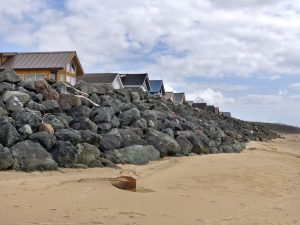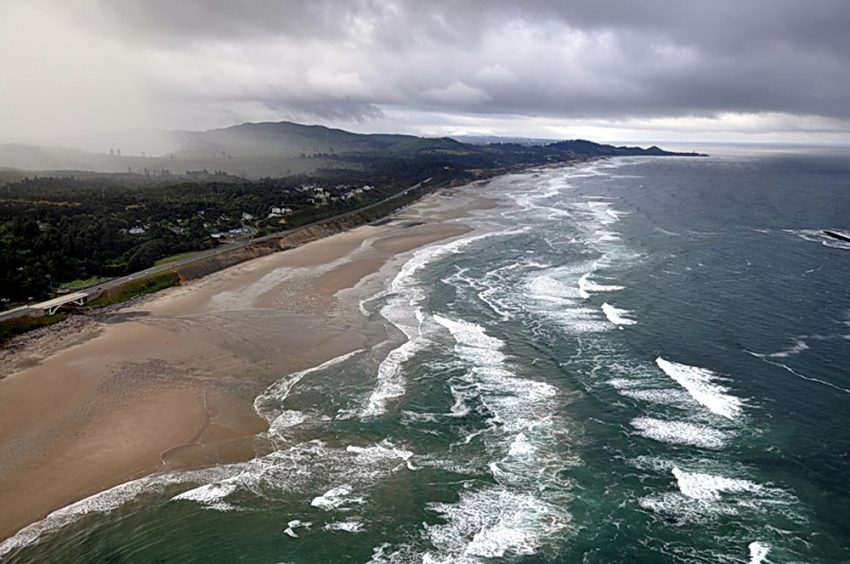By Phillip Johnson and Charlie Plybon
Oregonians have the freedom to wander wherever they wish on the Oregon shore. The public is endowed with what is known as a “customary use right” to visit all 362 miles of our ocean beaches and rocky shores. Few citizens of other states enjoy this kind of unfettered access along the beach that was ensured for Oregonians and their visitors by our celebrated Beach Bill, initially passed by the legislature in 1967.
Today, however, this Oregonian legacy is under threat. Not because anyone is scheming to take away our rights—at least, not directly. Yet human actions are threatening our beaches from both directions. We may retain our access to the shore, but in coming years our access along the beach could be lost.
In Oregon, we like to say that “the beaches belong to the people,” but that isn’t exactly right. The key principle isn’t ownership, in the sense of property. Rather, our right to travel the shoreline is based on something deeper and older, the customary use that goes back to the region’s tribal history and continued on through European settlement. This public trust is established through a recreation zone that covers the entire shoreline. In Oregon, the beaches are common ground for everyone.
Oregon’s entire shoreline has been public long enough that we tend to take this access for granted. When contemplating a visit to the waves, we just think in terms of where we want to go, not where we are allowed to be.
But our shoreline is now caught in what is known as the “coastal squeeze.” Sea level rise and increased storm surges, driven by climate change, are pushing waves and tides higher and higher, speeding up erosion and flooding the beach more frequently. And on the landward side, more and more landowners are seeking to protect their property from those higher waves with shoreline armoring, such as seawalls and riprap revetments (structures made of boulders).
Over time, this will be a deadly combination. Hardened structures lead to increased erosion, both by deflecting waves onto adjoining shoreland and by causing scour at the front of the structure. At the same time, they deprive beaches of their natural sand supply. Higher seas and stronger storms pull sand offshore, but if nature is allowed to take its course, they replenish the beach by mobilizing sand from bluffs and dunes as they move upslope. Deprived of this fresh sand supply, beaches will narrow, becoming inaccessible to people first at high tide, and then at lower and lower tide levels. Eventually, beaches may disappear entirely, as waves slap against solid walls and riprap forms artificial peninsulas protecting a handful of coastal property owners.
Loss of the beach wouldn’t just be a disaster for Oregonians who love the coast. The shoreline is also habitat for a range of plants and animals, from snowy plovers to sand verbena to seals. Our beaches are especially critical to migratory shorebirds, as they stop over on their travels from hemisphere to hemisphere.

The desire of property owners to preserve their assets is understandable and they can always rationalize that one seawall spanning a limited stretch of the shore won’t destroy the beach. But shoreline armoring has a cumulative effect, with each structure further accelerating the eventual erosion of entire stretches of the beach. Statewide Land Use Goal #18 restricts armoring to properties developed by Jan. 1, 1977, but this is a flimsy barrier. Cities and counties, confronted by concerned and often litigious landowners, are beginning to more frequently issue “exceptions” to allow riprap and shoreline armoring of otherwise ineligible properties.Unless we change course, shoreline armoring will spread along our coast at the expense of our public beaches, depriving Oregonians of recreation and leisure, while also irrevocably damaging shoreline ecosystems. Clearly, we need to step back, consider the future of our beaches, and develop new policies that will enable us to preserve this precious resource.
The Oregon Shores Conservation Coalition and the Surfrider Foundation are partnering in a new campaign, Oregon Beaches Forever, designed to foster a statewide conversation about our public shoreline. This will be a long-term effort to educate our community on the geology of the coast and the impending consequences of climate change, as well as our best available planning options to deal with these implications, to save Oregon’s beaches.. We will be working together to develop a common understanding of the challenges facing our common shoreline—and from there, create a constituency for change.
We don’t profess to know for sure at this point what the best policies would be for Oregon. In other states and countries, a variety of approaches are being undertaken, from outright buyouts of threatened properties, to rolling easements (in which land is rezoned as untenable for development once reached by high waters), to transfer development rights (through which owners give up their property in return for permission to develop at greater density elsewhere). Various practical and policy experiments are underway. Our goal is to study the alternatives and present them to Oregonians and our local decision-makers, so we can decide together how best to preserve our beaches in the era of climate change.
For generations now, Oregonians and their visitors have cherished Oregon’s coast and public beaches. The ultimate goal of Oregon Beaches Forever is to assure that this shared inheritance is enjoyed by many more generations to come. To do this, we will have to build a vision and a movement for long-term shoreline protection. We urge all Oregonians who share our love for the Oregon coast to join us in this effort.
Phillip Johnson is the Shoreline and Land Use Manager for the Oregon Shores Conservation Coalition.
Charlie Plybon is the Sr. Oregon Policy Manager for Surfrider Foundation


